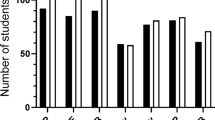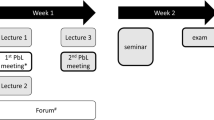Abstract
The objective of this study was to assess if online teaching delivery produces comparable student test performance as the traditional face-to-face approach irrespective of academic aptitude. This study involves a quasi-experimental comparison of student performance in an undergraduate health science statistics course partitioned in two ways. The first partition involves one group of students taught with a traditional face-to-face classroom approach and the other through a completely online instructional approach. The second partition of the subjects categorized the academic aptitude of the students into groups of higher and lower academically performing based on their assignment grades during the course. Controls that were placed on the study to reduce the possibility of confounding variables were: the same instructor taught both groups covering the same subject information, using the same assessment methods and delivered over the same period of time. The results of this study indicate that online teaching delivery is as effective as a traditional face-to-face approach in terms of producing comparable student test performance but only if the student is academically higher performing. For academically lower performing students, the online delivery method produced significantly poorer student test results compared to those lower performing students taught in a traditional face-to-face environment.


Similar content being viewed by others
References
Bloom, B. S., Engelhart, M. D., Furst, E. J., Hill, W. H., & Krathwohl, D. R. (1956). Taxonomy of educational objectives: The classification of educational goals. Handbook 1: Cognitive domain. New York: David McKay.
Campbell, M., Gibson, W., Hall, A., Richards, D., & Callery, P. (2008). Online versus face-to-face discussion in a web-based research methods course for postgraduate nursing students: A quasi-experimental study. International Journal of Nursing Studies, 45, 750–759.
Collins, J., & Pascarella, E. T. (2003). Learning on campus and learning at a distance: A randomized instructional experiment. Research in Higher Education, 44(3), 315–326. Retrieved July 20, 2008 from http://www.springerlink.com/content/un74220tx647wx60/.
Cook, D. A. (2007). Web-based learning: Pros, cons and controversies. Clinical Medicine, 7, 37–42.
de Jong, N., Verstegen, D. M. L, Tan, F. E. S., & O’Connor, S. J. (2012). A comparison of classroom and online asynchronous problem-based learning for students undertaking statistics training as part of a Public Health Masters degree. Advances in Health Science Education (Epub ahead of print). Retrieved June 26, 2012 from http://www.springerlink.com/content/j6338055272321n7/.
Ellaway, R., & Masters, K. (2008). AMEE Guide 32: E-learning in medical education, Part 1: Learning, teaching and assessment. Medical Teacher, 20, 455–473.
Garavilia, L. S., & Gredler, M. E. (2002). Prior achievement, aptitude and use of learning strategies as predictors of college student achievement. College Student Journal, 36(4), 616–625.
Garrison, D. R., & Kanuka, H. (2004). Blended-learning: Uncovering its transformative potential in higher education. The Internet and Higher Education, 7, 95–105.
Goodrich, C. (2007). Using web-based software to enhance learning of analytical and critical skills. Journal of Educational Technology Systems, 36, 247–253.
Huitt, W. (2011). Bloom et al.’s taxonomy of the cognitive domain. Educational Psychology Interactive. Valdosta, GA: Valdosta State University. Retrieved March 22, 2011 from http://www.edpsycinteractive.org/topics/cogsys/bloom.html.
Krathwohl, D. (2002). A revision of Bloom’s taxonomy: An overview. Theory Into Practice, 41(4), 212–218.
Le, A., Joordens, S., Chrysostomou, S., & Grinnel, R. (2010). Online lecture accessibility and its influence on performance in skills-based courses. Computers & Education, 55, 313–319.
Qiu, M. (2010). A mixed methods study of class size and group configuration in online graduate course discussions. Dissertation for the Degree of Doctor of Philosophy Department of Curriculum, Teaching, and Learning, Ontario Institute for Studies in Education. University of Toronto.
Riffell, S., & Sibley, D. (2005). Using web-based instruction to improve large undergraduate biology courses: An evaluation of a hybrid course format. Computers & Education, 44, 217–235.
Romano, J., Wallace, T. L., Helmick, I. J., Carey, L. M., & Adkins, L. (2005). Study procrastination, achievement, and academic motivation in web-based and blended distance learning. The Internet and Higher Education, 8, 299–305.
Ross, T. K., & Bell, P. D. (2007). “No significant difference” only on the surface. International Journal of Instructional Technology and Distance Learning, 4(7), 3–13.
Russell, T. L. (1999). The no significant difference phenomenon. USA: Office of Instructional Telecommunications, North Carolina State University.
Sitzmann, T., Kraiger, K., Stewart, D., & Wisher, R. (2006). The comparative effectiveness of web-based and classroom instruction: A meta-analysis. Personnel Psychology, 59, 623–664.
Wieling, M. B., & Hofman, W. H. A. (2010). The impact of online video lecture recordings and automated feedback on student performance. Computers & Education, 54, 992–998.
Young, J. D. (1996). The effect of self-regulated learning strategies on performance in learner controlled computer-based instruction. Educational Technology Research and Development, 44(2), 17–27.
Author information
Authors and Affiliations
Corresponding author
Rights and permissions
About this article
Cite this article
Lu, F., Lemonde, M. A comparison of online versus face-to-face teaching delivery in statistics instruction for undergraduate health science students. Adv in Health Sci Educ 18, 963–973 (2013). https://doi.org/10.1007/s10459-012-9435-3
Received:
Accepted:
Published:
Issue Date:
DOI: https://doi.org/10.1007/s10459-012-9435-3




